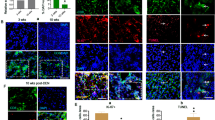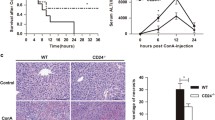Abstract.
Apoptosis of T cells contributes to the immune homeostasis in inflamed organs. A prominent T-cell infiltration is usually seen in human chronic active hepatitis, being associated with liver fibrosis. In order to demonstrate T-cell apoptosis in the hepatic fibrotic tissue, we induced T-cell infiltration in the fibrotic liver of the rat by injecting concanavalin A (Con A), a T-cell mitogen. Lymphocytes increased in number with a peak at 1 day, preferentially distributing in the fibrotic tissue rather than the parenchyma. They consisted of CD4-positive and CD8-positive cells, and gave the feature of lymphoblasts. Double staining for CD3 and TUNEL demonstrated that T cells underwent apoptosis. Apoptotic cells were more frequent in the fibrotic livers than the normal livers, and were spatially associated with alpha-smooth muscle actin-positive myofibroblast-like cells that possibly derived from hepatic stellate cells (HSCs) and portal fibroblasts through activation. In vitro experiments demonstrated that lymphocyte apoptosis was more frequently induced in the co-culture of Con A-activated splenic T cells/activated HSCs compared to that induced in activated T cells/quiescent HSCs or resting T cells/activated HSCs. The present results indicate that T cells which have extravasated and infiltrated the hepatic fibrotic tissue undergo apoptosis probably through an interaction with myofibroblast-like cells, suggesting the regulatory role of the latter cells in T-cell accumulation in the fibrotic liver.











Similar content being viewed by others
References
Abraham D, Bou-Gharios G, Tulip G, Sumner H, Olsen I (1994) Regulation of CD2-mediated heterotypic interactions of murine T lymphocytes. Cell Immunol 156:342–256
Akbar AN, Salmon M, Janossy G (1994) Role of bcl-2 and apoptosis in viral infections. Int Arch Allergy Immunol 105:359–356
Bach-Kristensen D, Kawada N, Imamura K, Miyamoto Y, Tateno C, Seki S, Kuroki T, Yoshizato K (2000) Proteome analysis of rat hepatic stellate cells. Hepatology 32:268–277
Bhunchet E, Wake K (1992) Role of mesenchymal cell populations in porcine serum-induced rat liver fibrosis. Hepatology 16:1452–1473
Bianchi L, Gudat F (1994) Chronic hepatitis. In: MacSween RNM, Anthony PP, Scheuer PJ, Burt AD, Portmann BC (eds) Pathology of the liver, 3rd edn. Churchill Livingstone, Edinburgh, pp 349–395
Chen D, MacKallip RJ, Zeytun A, Do Y, Lombard C, Robertson JL, Mak TW, Nagarkatti PS, Nagarkatti M (2001) CD44-deficient mice exhibit enhanced hepatitis after concanavalin A injection: evidence for involvement of CD44 in activation-induced cell death. J Immunol 166:5889–5897
Colucci G, Colombo M, Del Ninno E, Paronetto F (1983) In situ characterization by monoclonal antibodies of the mononuclear cell infiltrate in chronic active hepatitis. Gastroenterology 85:1138–1145
Crowston JG, Salmon M, Khaw PT, Akbar AN (1997) T-lymphocyte-fibroblast interactions. Biochem Soc Trans 25:529–531
Eggink HF, Houthoff HJ, Huitema S, Gips CH, Poppema S (1982) Cellular and humoral immune reactions in chronic active liver disease. I. Lymphocyte subsets in liver biopsies of patients with untreated idiopathic autoimmune hepatitis, chronic active hepatitis B and primary biliary cirrhosis. Clin Exp Immunol 50:17–24
Friedman SL (1993) The cellular basis of hepatic fibrosis. Mechanisms and treatment strategies. N Engl J Med 328:1828–1835
Fujikura S, Mizuhara H, Miyazawa Y, Fujiwara H, Kaneda K (1996) Kinetics and localization of lymphoblasts that proliferate in the murine liver after concanavalin A administration. Biomed Res 17:129–139
Gantner F, Leist M, Lohse AW, Germann PG, Tiegs G (1995) Concanavalin A-induced T-cell mediated hepatic injury in mice: the role of tumor necrosis factor. Hepatology 21:190–198
Geerts A, De Bleser P, Hautekeete ML, Niki T, Wisse E (1994) Fat-storing (Ito) cell biology. In: Arias IM, Boyer JL, Fausto N, Jakoby WB, Schachter DA, Shafritz DA (eds) The liver: biology and pathobiology, 3rd edn. Raven Press, New York, pp 819–838
Gressner AM, Bachem MG (1990) Cellular sources of noncollagenous matrix proteins; role of fat-storing cells in fibrogenesis. Semin Liver Dis 10:30–46
Hellerbrand, Wang S-C, Tsukamoto H, Brenner DA, Rippe RA (1996) Expression of intercellular adhesion molecule 1 by activated hepatic stellate cells. Hepatology 24:670–676
Huang L, Soldevila G, Leeker M, Flavell R, Crispe IN (1994) The liver eliminates T cells undergoing antigen-triggered apoptosis in vivo. Immunity 1:741–749
Ikeda K, Wakahara T, Wang YQ, Kadoya H, Kawada N, Kaneda K (1999) In vitro migratory potential of rat quiescent hepatic stellate cells and its augmentation by cell activation. Hepatology 29:1760–1767
Kita H, Mackay IR, van de Water J, Gershwin ME (2001) The lymphoid liver: considerations on pathways to autoimmune injury. Gastroenterology 120:1485–1501
Knittel T, Dinter C, Kobold D, Neubauer K, Mehde M, Eichhorst S, Ramadori G (1999) Expression and regulation of cell adhesion molecules by hepatic stellate cells (HSC) of rat liver: involvement of HSC in recruitment of inflammatory cells during hepatic tissue repair. Am J Pathol 154:153–167
Kudo S, Matsuno K, Ezaki T, Ogawa M (1997) A novel migration pathway for rat dendritic cells from the blood: hepatic sinusoids-lymph translocation. J Exp Med 185:777–784
Marra F (1999) Hepatic stellate cells and the regulation of liver inflammation. J Hepatol 31:1120–1130
McGirl A, Shea G, Melinn M, McLaughlin H (1990) Morphological and quantitative aspects of the development of cytoplasmic granules in concanavalin A-stimulated normal human lymphocytes. J Leukoc Biol 47:514–518
Mehal WZ, Juedes AE, Crispe IN (1999) Selective retention of activated CD8+ T cells by the normal liver. J Immunol 163:3202–3210
Mehal WZ, Azzaroli F, Crispe N (2001) Immunology of the healthy liver: old questions and new insights. Gastroenterology 120:250–260
Milik AM, Buechner-Maxwell VA, Sonstein J, Kim S, Seitzman GD, Beals TF, Curtis JL (1997) Lung lymphocyte elimination by apoptosis in the murine response to intratracheal particulate antigen. J Clin Invest 99:1082–1091
Morikawa H, Hachiya K, Mizuhara H, Fujiwara H, Nishiguchi S, Shiomi S, Kuroki T, Kaneda K (2000) Sublobular veins as the main site of lymphocyte adhesion/transmigration and adhesion molecule expression in the porto-sinusoidal-hepatic venous system during concanavalin A-induced hepatitis in mice. Hepatology 31:83–94
Nakatani K, Seki S, Kawada N, Kitada T, Yamada T, Sakaguchi H, Kadoya H, Ikeda K, Kaneda K (2002) Expression of SPARC by activated hepatic stellate cells and its correlation with the stages of fibrogenesis in human chronic hepatitis. Virchows Archiv 411:466–474
Nishihara E, Nagayama Y, Inoue S, Hiroi H, Muramatsu M, Yamashita S, Koji T (2000) Ontogenic changes in the expression of estrogen receptor alpha and beta in rat pituitary gland detected by immunohistochemistry. Endocrinology 141:615–620
Perillo NL, Pace KE, Seihamer JJ, Baum LG (1995) Apoptosis of T cells mediated by galectin-1. Nature 378:736–739
Ramadori G, Veit T, Schwogler S, Dienes HP, Knittel T, Rieder H, Meyer zum Buchenfelde K-H (1990) Expression of the gene of the α-smooth muscle actin isoform in rat liver and in rat fat-storing (ITO) cells. Virchows Archiv B Cell Pathol 59:349–357
Saio M, Radoja S, Marino M, Frey AB (2001) Tumor-infiltrating macrophages induce apoptosis in activated CD8(+) T cells by a mechanism requiring cell contact and mediated by both the cell-associated form of TNF and nitric oxide. J Immunol 167:5583–5593
Santucci L, Fiorucci S, Cammilleri F, Servillo G, Federici B, Morelli A (2000) Galectin-1 exerts immunomodulatory and protective effects on concanavalin A-induced hepatitis in mice. Hepatology 31:399–406
Schwabe RF, Schnabl B, Kweon YO, Brenner DA (2001) CD40 activates NF-κB and c-Jun N-terminal kinase and enhances chemokine secretion on activated human hepatic stellate cells. J Immunol 166:6812–6819
Smith DJ, McGuire MJ, Tocci MJ, Thiele DL (1997) IL-1β convertase (ICE) does not play a requisite role in apoptosis induced in T lymphoblasts by Fas-dependent or Fas-independent CTL effector mechanisms. J Immunol 158:163–170
Takeda K, Hayakawa Y, Van Kaer L, Matsuda H, Yagita H, Okumura K (2000) Critical contribution of liver natural killer T cells to a murine model of hepatitis. Proc Natl Acad Sci U S A 97:5498–5503
Tiegs G, Hentschel J, Wendel A (1992) A T cell-dependent experimental liver injury in mice inducible by concanavalin A. J Clin Invest 90:196–203
Toyabe S, Seki S, Iiai T, Takeda K, Shirai K, Watanabe H, Hiraide H, Uchiyama M, Abo T (1997) Requirement of IL-4 and liver NK1+T cells for concanavalin A-induced hepatic injury in mice. J Immunol 159:1537–1542
Tuchweber B, Desmouliere A, Bochanton PM, Rubbia BL, Gabbiani G (1996) Proliferation and phenotypic modulation of portal fibroblasts in the early stages of cholestatic fibrosis in the rat. Lab Invest 74:265–278
Van Parijs L, Abbas AK (1998) Homeostasis and self-tolerance in the immune system: turning lymphocytes off. Science 280:243–248
Wahl SM (1985) The role of lymphokines and monokines in fibrosis. Ann N Y Acad Sci 460:224–231
Wang YQ, Ikeda K, Ikebe T, Hirakawa K, Sowa M, Nakatani K, Kawada N, Kaneda K (2000) Inhibition of hepatic stellate cell proliferation and activation by the semisynthetic analogue of fumagillin TNP-470 in rats. Hepatology 32:980–989
Yarovinsky TO, Hunninghake GW (2001) Lung fibroblasts inhibit activation-induced death of T cells through PGE2-dependent mechanism. Am J Physiol Lung Cell Mol Physiol 281:L1248–1256
Acknowledgements.
The authors wish to thank Ms. Miki Yamauchi, Department of Anatomy, Graduate School of Medicine, Osaka City University, for her technical help in preparing histological sections.
Author information
Authors and Affiliations
Corresponding author
Rights and permissions
About this article
Cite this article
Kobayashi, S., Seki, S., Kawada, N. et al. Apoptosis of T cells in the hepatic fibrotic tissue of the rat: a possible inducing role of hepatic myofibroblast-like cells. Cell Tissue Res 311, 353–364 (2003). https://doi.org/10.1007/s00441-002-0670-4
Received:
Accepted:
Published:
Issue Date:
DOI: https://doi.org/10.1007/s00441-002-0670-4




